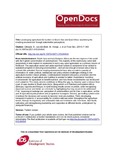| dc.contributor.author | Gillespie, Stuart | |
| dc.contributor.author | van den Bold, Mara | |
| dc.contributor.author | Hodge, Judith | |
| dc.contributor.author | Herforth, Anna | |
| dc.coverage.spatial | India | en |
| dc.coverage.spatial | Pakistan | en |
| dc.coverage.spatial | Bangladesh | en |
| dc.coverage.spatial | Ethiopia | en |
| dc.coverage.spatial | Uganda | en |
| dc.coverage.spatial | Kenya | en |
| dc.date.accessioned | 2016-08-15T14:26:09Z | |
| dc.date.available | 2016-08-15T14:26:09Z | |
| dc.date.issued | 2015-06 | |
| dc.identifier.citation | Gillespie, S. et al., (2015) Leveraging agriculture for nutrition in South Asia and East Africa: examining the enabling environment through stakeholder perceptions, Food Security, Vol. 7, Iss. 3, pp 463–477. | en |
| dc.identifier.issn | 1876-4517 | |
| dc.identifier.uri | https://opendocs.ids.ac.uk/opendocs/handle/20.500.12413/12158 | |
| dc.description.abstract | South Asia and sub-Saharan Africa are the two regions of the world with the highest concentration of undernutrition. The majority of the nutritionally vulnerable populations in both regions is dependent in some way upon agriculture as a primary source of livelihood. The agriculture sector and wider agri-food system is considered to be central to sustained progress in reducing undernutrition – and yet not enough is known about how to unleash this potential. Recent scoping assessments have also revealed a paucity of information on wider political, institutional and policy-related challenges relating to the agriculture-nutrition nexus globally. Contextualized research into policy processes and the political economy of agriculture and nutrition is needed to better characterize “enabling environments” for agriculture to benefit nutrition, and how these environments can be shaped and sustained. This study aims to contribute to filling this gap, by drawing upon evidence from a set of case studies in South Asia (India, Bangladesh and Pakistan) and eastern Africa (Ethiopia, Uganda and Kenya). In synthesizing results across countries, while recognizing important nuance and detail, we conclude by highlighting four key issues to be addressed. First, improving knowledge and perception of undernutrition and its links to agriculture, on the part of agricultural policymakers and programme managers. Second, generating system-wide incentives for decisions and actions to become more pro-nutrition. Third, developing transparent systems of accountability for nutrition-relevant action throughout the agriculture sector, through linking timely and actionable data and evidence with incentives. And fourth, cultivating and strengthening leadership and capacities at different levels, underpinned by adequate financing. | en |
| dc.description.sponsorship | UK Aid | en |
| dc.description.sponsorship | Department for International Development (DFID) | en |
| dc.language.iso | en | en |
| dc.publisher | Springer | en |
| dc.rights.uri | http://creativecommons.org/licenses/by-nc-nd/4.0/ | en |
| dc.title | Leveraging agriculture for nutrition in South Asia and East Africa: examining the enabling environment through stakeholder perceptions | en |
| dc.type | Article | en |
| dc.rights.holder | Springer | en |
| dc.identifier.externaluri | http://dx.doi.org/10.1007/s12571-015-0449-6 | en |
| dc.identifier.doi | 10.1007/s12571-015-0449-6 | |
| dcterms.dateAccepted | 2015-05 | |
| rioxxterms.funder | Department for International Development, UK Government | |
| rioxxterms.identifier.project | LANSA | |
| rioxxterms.version | AM | en |
| rioxxterms.versionofrecord | 10.1007/s12571-015-0449-6 | en |
| rioxxterms.funder.project | 752f8189-3789-4438-be29-585edbe66660 | |


